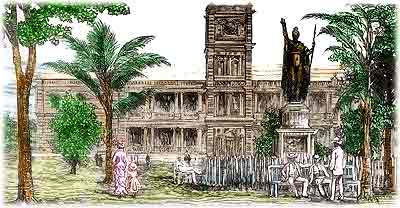44b. Hawaiian Annexation

By the time the United States got serious about looking beyond its own borders to conquer new lands, much of the world had already been claimed. Only a few distant territories in Africa and Asia and remote islands in the Pacific remained free from imperial grasp. Hawaii was one such plum. Led by a hereditary monarch, the inhabitants of the kingdom prevailed as an independent state. American expansionists looked with greed on the strategically located islands and waited patiently to plan their move.
Foothold in Hawaii
Interest in Hawaii began in America as early as the 1820s, when New England missionaries tried in earnest to spread their faith. Since the 1840s, keeping European powers out of Hawaii became a principal foreign policy goal. Americans acquired a true foothold in Hawaii as a result of the sugar trade. The United States government provided generous terms to Hawaiian sugar growers, and after the Civil War, profits began to swell. A turning point in U.S.-Hawaiian relations occurred in 1890, when Congress approved the McKinley Tariff, which raised import rates on foreign sugar. Hawaiian sugar planters were now being undersold in the American market, and as a result, a depression swept the islands. The sugar growers, mostly white Americans, knew that if Hawaii were to be annexed by the United States, the tariff problem would naturally disappear. At the same time, the Hawaiian throne was passed to Queen Liliuokalani, who determined that the root of Hawaii's problems was foreign interference. A great showdown was about to unfold.
Annexing Hawaii
In January 1893, the planters staged an uprising to overthrow the Queen. At the same time, they appealed to the United States armed forces for protection. Without Presidential approval, marines stormed the islands, and the American minister to the islands raised the stars and stripes in Honolulu. The Queen was forced to abdicate, and the matter was left for Washington politicians to settle. By this time, Grover Cleveland had been inaugurated President. Cleveland was an outspoken anti-imperialist and thought Americans had acted shamefully in Hawaii. He withdrew the annexation treaty from the Senate and ordered an investigation into potential wrongdoings. Cleveland aimed to restore Liliuokalani to her throne, but American public sentiment strongly favored annexation.
The matter was prolonged until after Cleveland left office. When war broke out with Spain in 1898, the military significance of Hawaiian naval bases as a way station to the Spanish Philippines outweighed all other considerations. President William McKinley signed a joint resolution annexing the islands, much like the manner in which Texas joined the Union in 1845. Hawaii remained a territory until granted statehood as the fiftieth state in 1959.






